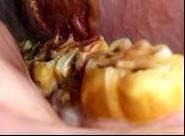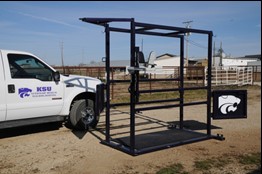From the Horses’ Mouth: Their Teeth Are Always Changing
Chris Blevins, MS, DVM, Equine Field Service
 |
| Figure 1: photograph of a horse with sharp enamel points and an oral ulceration. The points are so sharp that they have caused damage to the lining of the oral cavity in this horse. |
|

|
| Figure 2: Photograph of oral examination and Photograph of equipment used to examine the equine mouth. |
|

|
| Figure 3: Oral exam digital charting used at VHC during equine oral examination. |
|

|
| Figure 4: Portable equine stocks used at VHC during oral exams in the field. |
Horse teeth differ from human teeth in a variety of ways. The biggest difference is that horse teeth continue to erupt (grow out of the gum line) throughout the life of the horse. Yes, that’s right, so if the horse is getting up there this is why we say they are getting “long in the tooth!” You may be wondering why they do not have giant tusks growing out of their mouth and that is because they have directly opposing teeth, which wear on each other while they chew. Eruption and wear are equal in the healthy horse mouth. However, problems arise when the eruption and wear are uneven. When horses have uneven tooth wear the horse typically develops malocclusions (uneven teeth/wear) and sharp points causing soft tissue ulcers (Figure 1). It is not uncommon for horse owners to be unaware of problems in the oral cavity of the horse until marked dental changes have developed.
Some of the signs that indicate a horse is having trouble eating include balling up of roughage, called “quidding”. Other signs may include weight loss, or eating with an abnormal head position, such as a head tilt. In some cases, dental malocclusions can put the horse at risk for colonic impaction (a type of colic) or esophageal obstruction (choke).
The good news is that you do not have to get too worried. Fortunately there are things that can be done to help improve the oral health in your horse. Typically the first place to start is with a thorough oral examination. This is completed by a veterinarian because in order to complete a thorough examination the horse needs to be sedated and have an oral (mouth) speculum placed so that an optimal view can be achieved. Additional tools will include a light source and a dental mirror (Figure 2). Routine dental examination and oral care are essential for preventative health management. The equine oral cavity should be examined at least once a year (during vaccination) to determine health status and identify if problems exist. In addition to weight loss and abnormal chewing, training and bit issues may be identified with a thorough oral examination (including evaluation for wolf teeth) and evaluation of the bit and bridle.This examination is documented in the veterinary medical record and will enable the veterinarian to track the progression of the changes within the mouth (in addition to body condition, weight, or any other abnormalities; Figure 3).
At the Veterinary Health Center at Kansas State University we can thoroughly examine the equine oral cavity. Dental floatation is performed with the power floating equipment for occlusal equilibration in the mobile clinic restraint stocks (Figure 4).
Good dental health will improve the overall health status of your horse and will aid with feed efficiency and body condition.
If you have any questions regarding dental care for your horse, please don’t hesitate to give us a call: 785-532-5700.
For more information, see AAEP's guidelines for dental care here.



